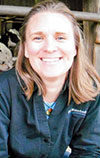I don’t know how many times I’ve uttered, “Technology is great … when it works.” And it seems like, today, more and more of us are adding, “Technology is great ... when it works and doesn’t interfere with work.”
There have been many positive, productive technological advances that have made farming more efficient and profitable – and many of those come in some form of using a cellphone.
Those hand-held devices have become the lifeline to our personal lives, the dairy and business operations. Communication is easier and faster. Information is readily shared and analyzed. Many aspects of our day would not be possible without the convenience and efficiency brought by cellphones.
However, cellphones can be a deadly distraction for cows.

A distracted milker in the parlor could improperly prepare a cow for milking, leading to infections in the teat ends. A distracted calf manager could miss the early signs of illness, leading to an unnecessary calf death.
A person cleaning the stalls in the barn could forget to latch a gate, and cows could get out. These are all serious concerns for a dairy farm.
Cellphones can also be a deadly distraction for your family, friends and employees.
“Distracted driving remains as dangerous as ever with 3,179 people killed in 2014 and 431,000 injured in motor vehicle crashes involving distracted drivers,” according to the government’s official website on distracted driving (distraction.gov).
The National Highway Traffic Safety Administration reported that “at any given daylight moment across America, approximately 660,000 drivers are using cellphones or manipulating electronic devices while driving.”
Some of these 660,000 drivers are on our farms, working in ag-related businesses supporting our customers and on the roads we use to haul milk and manure.
This summer, I watched a video (texting and driving video) where teens laugh as they admit to knowing it’s dangerous but texting, using Snapchat and checking Facebook while driving anyway.
I replaced Snapchat with “work email” and Facebook with “WhatsApp” for myself and realized: I know better but allow myself to be distracted when driving too.
For those who take the time to watch the video, I promise it will make an impact on you. For those who don’t have the three minutes and 51 seconds to watch the video, I’ll let you in on the ending.
A partially paralyzed young woman tells her story. On the way home from her college graduation, her parents were killed by a driver who was texting and driving. Watching the teens, who were only minutes earlier laughing and explaining why they needed to send a text or photo, break down and start crying left an imprint on my heart.
I realized that, at any point, I could be sitting in either of those chairs, trying to explain why the text or email couldn’t wait – or telling my story of a lost loved one.
Do your family, friends or employees know how you feel about distracted driving? Before watching the video, I hadn’t thought much about actively telling my friends and family, and certainly not my colleagues, that a reply to me can wait.
I looked at my employee and said, “Please do not make me call your wife to tell her you died because you were sending a work text message while driving.” To another, “Please don’t make me call your daughters to tell them you died sending a text message to me.”
We know the dangers of texting and driving a car down the road at 65 mph, but when the speeds are slower, it’s still just as dangerous. Don’t think just because you’re in a tractor hauling a manure tanker down the road and one hand is on the wheel, it’s OK to use the other to scroll through a Facebook feed.
A hand might be on the wheel, but where are your eyes and attention? What about taking a selfie while mixing feed? Or zooming around in the skid steer while quickly replying to a text message?
Such inattention can lead to costly property damage – taking out a mailbox or damaging an overhead door – but that is nothing compared to injuring or killing another person, the ultimate consequence of making the distractions of technology a higher priority than human life.
It probably wouldn’t hurt for you and your team to discuss when and where cellphone use is appropriate as it relates to cow handling and cow health.
You may want to write it down so you can reference it, but for me, the conversation about “A reply to me can wait” was more about telling my team that nothing was more important than their safety. ![]()
Amy Throndsen is the chief operating officer for DCC Waterbeds. Throndsen has nearly 10 years of experience in the dairy industry focusing on cow comfort in the dairy barn. She believes that if your dairy advisers aren’t asking you questions to make you uncomfortable and think differently about your dairy, they aren’t doing you any favors.
The video is part of the #ItCanWait campaign sponsored by AT&T. It is aimed at teens, but the message is universal.
References omitted but are available upon request. Click here to email an editor.

-
Amy Throndsen
- Director of Business Development
- Advanced Comfort Technology Inc.
- Email Amy Throndsen







